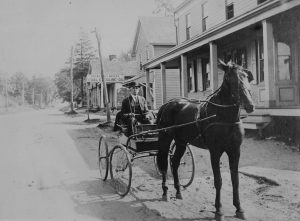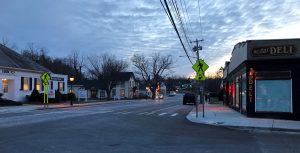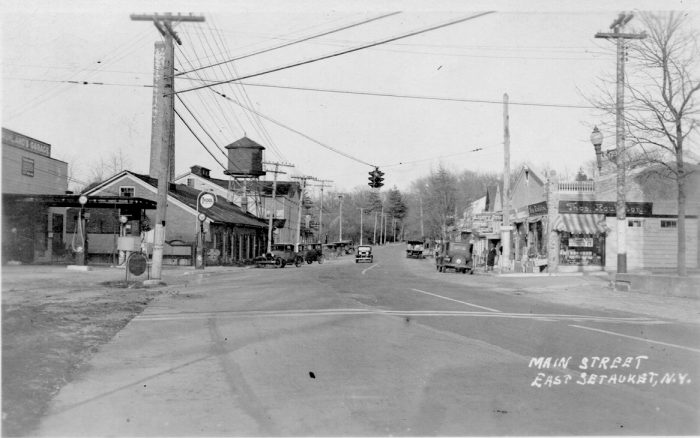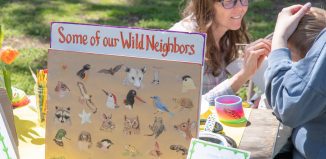The development of Main Street through the decades
The appearance of Main Street in East Setauket has changed considerably over the years with the needs of the business community. Today, this small historic business area is seeing a revitalization. Old businesses are sprucing up and new businesses are moving in. The park along the waterway is a delightful and favorite addition. Businesses looking for a local historic flavor should take a closer look at available locations along this small area of Route 25A.

In the 1800s, the business district of East Setauket was confined to an area between South Street, now Gnarled Hollow Road, and Baptist Avenue, now Shore Road. The village blacksmith shop, run by William Smith, stood where East Setauket Automotive is now and to the east were two wooden bridges that spanned the stream that still runs under 25A. The road was much lower then and the north side of the bridge was ideal for thirsty horses that were permitted to drink. The blacksmith shop was moved in the 1850s to a location on Gnarled Hollow Road where it was purchased in 1875 by Samuel West.
Over the years, the stores on the south side of Main Street changed with names such as Jones, Jayne, Smith, Bossey, Darling, Bellows and Rogers prominent among shop owners. Shops included a general store, meat market, shoe store, tailor, clothing shop and the usual combination of general store and post office. One of the shop owners in the late 1890s was Charles E. Smith. C.E., as he became known, was born in 1841 on his family’s farm in South Setauket. Before he was 20 years old, he was running a butcher wagon and had a large trade in the area. He established, according to the Port Jefferson Times, the first permanent meat market at East Setauket and later became the owner of the general store founded by his father-in-law, Carlton Jayne. His brother, Orlando Smith, ran a butcher shop in Stony Brook.
Charles E. Smith was very successful and eventually owned a great deal of property, including acreage where the Stony Brook University is now and other land across Route 25A from the old East Setauket schoolhouse. The house on the southwest corner of Coach Road and 25A became his home by the early years of the 20th century and his general store stood on the present empty lot west of what is now HSBC Bank.
All his life, he was a lover of good trotting horses and delighted in driving them. His last horse was a spirited one named Sporting Bill. He used to race Bill at the Hulse track in East Setauket and the story of the race between Irish Mag and Sporting Bill is detailed in the book, “Setauket, The First 300 Years.” Sporting Bill was stabled in the Hawkins barn that was later destroyed to make way for a housing development along Old Town Road.

Charlie Bickford remembered working with the horse for C.E. “I was scared of him as a boy. The horse was skittish and even bit me on the shoulder once. One day, C.E. told one of the fellows to get Bill out of the barn and brush him down. They didn’t like that. When you went into the stall Bill would turn his head the other way and squeeze you against the stall. I worked a few summers for C.E. plowing his fields and spreading manure. One day, I was driving Bill to the fields behind the Stony Brook Railroad Station when he darted into the brush and nearly upset the wagon. He used to do that kind of thing quite often to brush the flies off his back.”
At the age of 82, Charles Smith was fatally injured when he was dragged under the teeth of a hay rake attached to his horse Sporting Bill. C.E. died on April 22, 1923, and was buried at Caroline Church in Setauket. The store of Charles Smith continued to operate as a general store through the 1950s.
Many other changes have taken place over the years. In 1926, the road was paved for the first time, and in 1928, the property on the southwest corner of 25A and Gnarled Hollow Road, called “Colonial Corners” by its owner Mr. LaRoche, was changed to its present appearance with the addition of a group of stores. The house on this site, which was at one time the home of blacksmith William Smith, remained behind the stores, but the entrance was changed so it faced Gnarled Hollow Road. When this writer was growing up it was the home of Sarah Ann Sells who worked as a laundress. I remember stopping there from time to time with school friend Larry Payne. Mrs. Sells always offered us a peanut butter sandwich.
Beverly C. Tyler is a Three Village Historical Society historian and author of books available from the society at 93 North Country Road, Setauket. For more information, call 631-751-3730. or visit www.tvhs.org.
Above, Main Street in East Setauket looking east about 1935. Below, Charles E. Smith and Sportin’ Bill in front of Smith’s general store in East Setauket. Photos from Beverly C. Tyler







